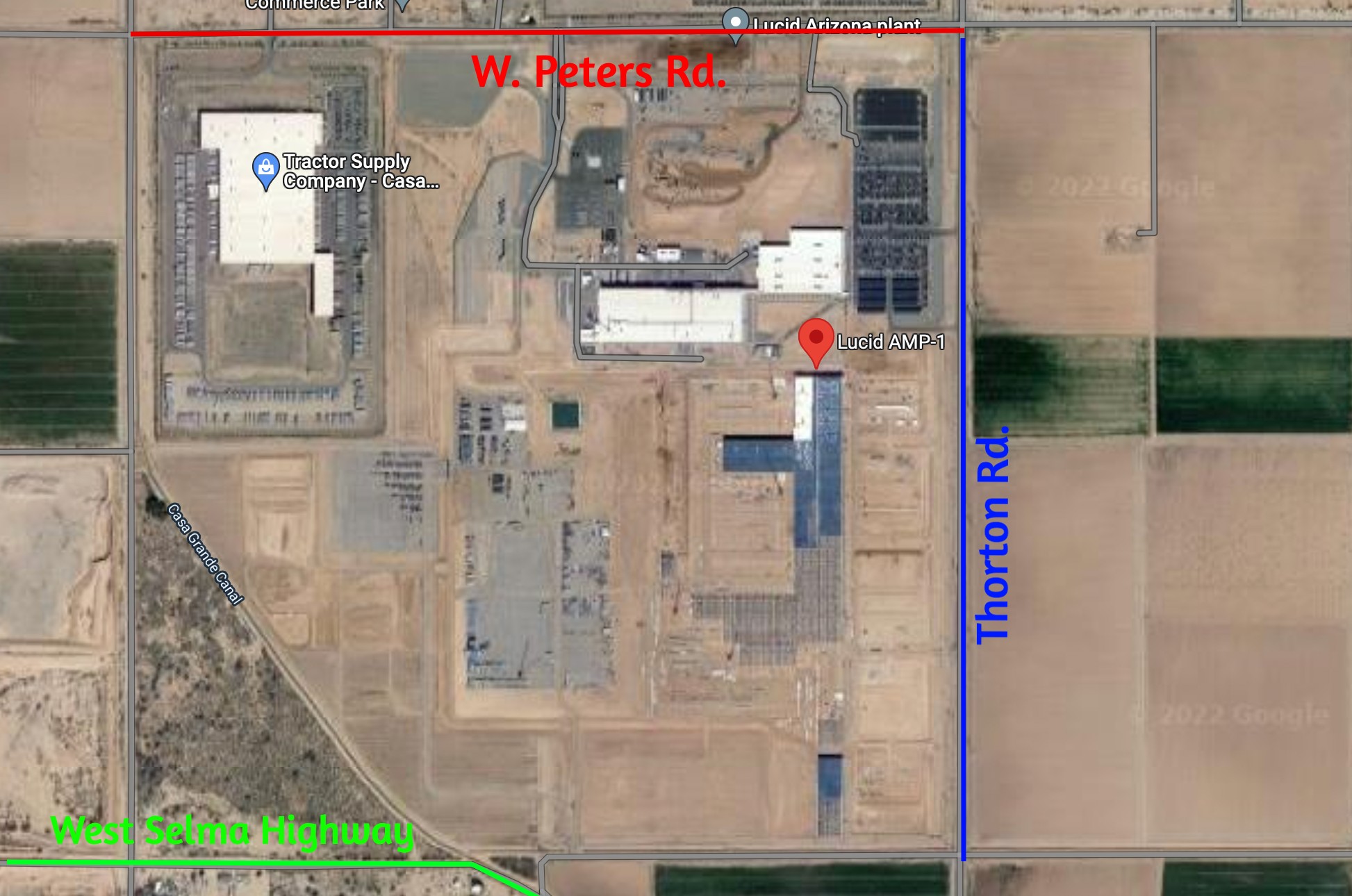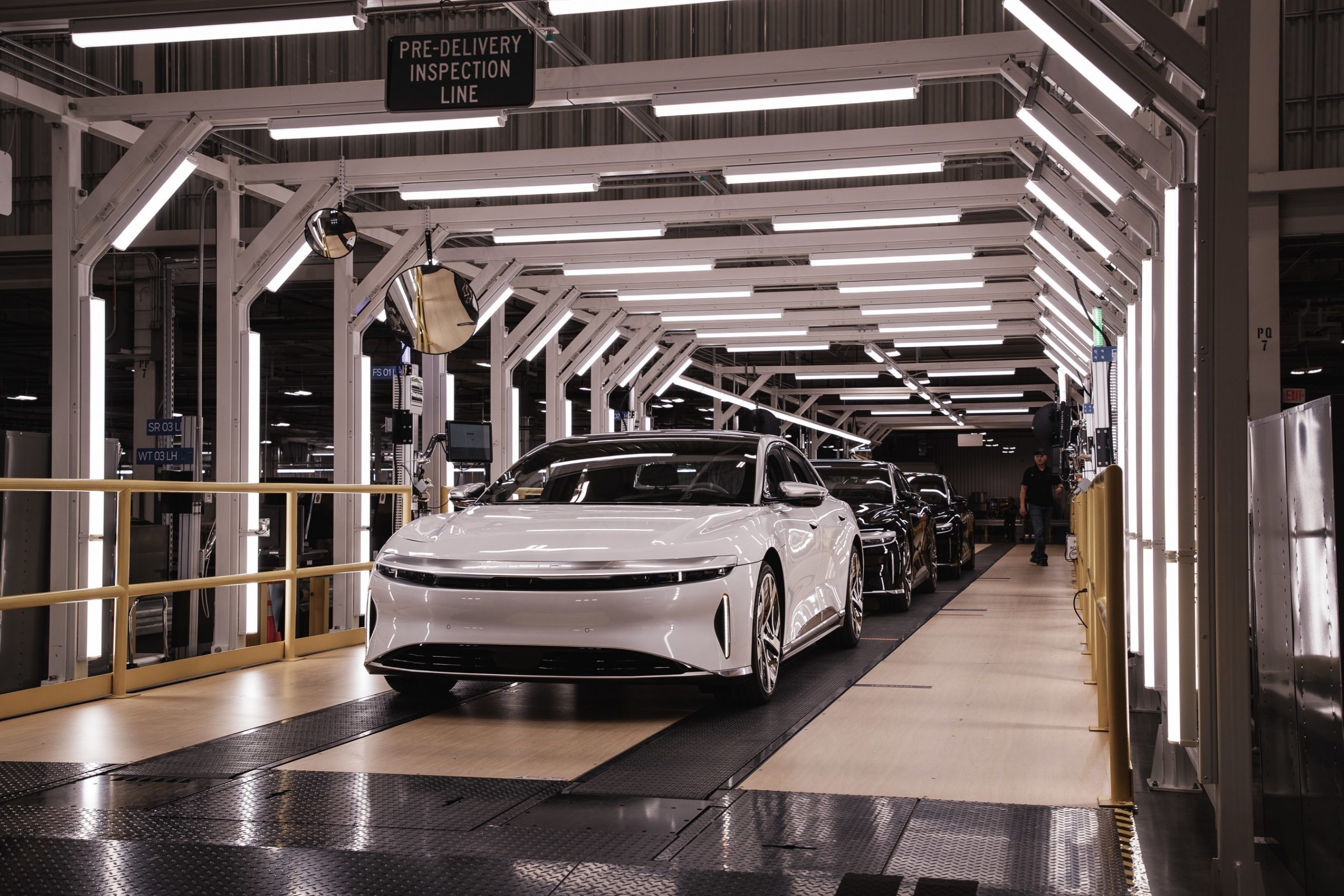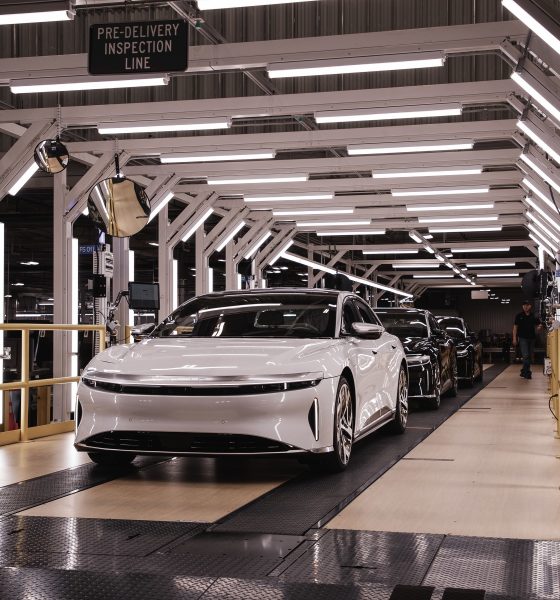Lucid Motors (NASDAQ: LCID) is planning to expand its AMP-1 production facility in Casa Grande, Arizona, with construction starting in 2023, documents show.
Lucid is set to begin construction on the third phase of its AMP-1 production plant sometime in 2023, with the project extending into 2024 and “possibly into 2025,” Teslarati learned.
Lucid’s current construction processes and discussions regarding Phase 3 are generalized in Casa Grande documents:
“Construction of the Phase 2 Lucid building is still underway and will be well into FY23. Additionally, Lucid is discussing starting work on future phases associated with the build-out of their development on Lot 1 of the Lucid Final Plat. This additional construction is likely to start in FY23 and run into FY24 and possibly into FY25.”
The Phase 3 expansion will not only build new buildings but will also increase the size of existing facilities, which will help support the company’s hopes of boosting production to 400,000 units every year. It will also add a Customer Experience Center, increasing foot traffic to Lucid’s production plant.
Lucid is preparing for an increase in vehicle traffic at the Casa Grande factory. Not only will an increase in vehicle production add more haulers to the local roadways, but the addition of a Customer Experience Center will add visiting vehicles to the property. Due to this, The City of Casa Grande is investing nearly $7 million to expand and improve roadways near the site, including Thornton Rd. from Peters Rd. to Selma Highway:
“The city is financially responsible for all aspects of the project, including payment to the EMW JV in the amount of $6,913,116.56 upon completion of their work. There is also included a project contingency amount of $315,247.44 for unforeseen conditions. Total Guaranteed Maximum Price Stage 2 (GMP 2) for Thornton Road – Selma Highway to Peters Road is $7,228,364.00.”
Lucid and the City of Casa Grande will expand roadways near the automaker’s AMP-1 facility. “Roadway construction improvements to Thornton Road are being conducted to increase the capacity of the road to facilitate the development of Lucid Motors and to assist in the safety and mobility of the traveling public in and around the area.” (Credit: Google Maps)
Currently, Lucid’s Phase 2 expansion is still underway. This expansion project, known as Phase 2, started in 2021 and is still being completed. It will not be finished until “well into 2023,” according to the documents seen by Teslarati.
In late 2020, we initially reported on the start of the Phase 2 expansion, which included the construction or modification of several facilities:
- Body in White Expansion
- Stamping Plant
- General Assembly
- Powertrain Plant
- General Warehousing
- Several Supporting and Auxiliary Structures
The Phase 2 expansion of the AMP-1 facility will supplement Lucid’s continuously-growing order bank, while Phase 3 will support new building construction and existing building expansion. The company has struggled to keep production lines rolling due to “extraordinary supply chain and logistics challenges,” it said during its recent Q2 Earnings Call. The automaker also slashed production output projections for the year by 50 percent, only expecting to build between 6,000 and 7,000 units in 2022.
I’d love to hear from you! If you have any comments, concerns, or questions, please email me at joey@teslarati.com. You can also reach me on Twitter @KlenderJoey, or if you have news tips, you can email us at tips@teslarati.com.

News
Tesla starts showing how FSD will change lives in Europe
Local officials tested the system on narrow country roads and were impressed by FSD’s smooth, human-like driving, with some calling the service a game-changer for everyday life in areas that are far from urban centers.

Tesla has launched Europe’s first public shuttle service using Full Self-Driving (Supervised) in the rural Eifelkreis Bitburg-Prüm region of Germany, demonstrating how the technology can restore independence and mobility for people who struggle with limited transport options.
Local officials tested the system on narrow country roads and were impressed by FSD’s smooth, human-like driving, with some calling the service a game-changer for everyday life in areas that are far from urban centers.
Officials see real impact on rural residents
Arzfeld Mayor Johannes Kuhl and District Administrator Andreas Kruppert personally tested the Tesla shuttle service. This allowed them to see just how well FSD navigated winding lanes and rural roads confidently. Kruppert said, “Autonomous driving sounds like science fiction to many, but we simply see here that it works totally well in rural regions too.” Kuhl, for his part, also noted that FSD “feels like a very experienced driver.”
The pilot complements the area’s “Citizen Bus” program, which provides on-demand rides for elderly residents who can no longer drive themselves. Tesla Europe shared a video of a demonstration of the service, highlighting how FSD gives people their freedom back, even in places where public transport is not as prevalent.
What the Ministry for Economic Affairs and Transport says
Rhineland-Palatinate’s Minister Daniela Schmitt supported the project, praising the collaboration that made this “first of its kind in Europe” possible. As per the ministry, the rural rollout for the service shows FSD’s potential beyond major cities, and it delivers tangible benefits like grocery runs, doctor visits, and social connections for isolated residents.
“Reliable and flexible mobility is especially vital in rural areas. With the launch of a shuttle service using self-driving vehicles (FSD supervised) by Tesla in the Eifelkreis Bitburg-Prüm, an innovative pilot project is now getting underway that complements local community bus services. It is the first project of its kind in Europe.
“The result is a real gain for rural mobility: greater accessibility, more flexibility and tangible benefits for everyday life. A strong signal for innovation, cooperation and future-oriented mobility beyond urban centers,” the ministry wrote in a LinkedIn post.
News
Tesla China quietly posts Robotaxi-related job listing
Tesla China is currently seeking a Low Voltage Electrical Engineer to work on circuit board design for the company’s autonomous vehicles.

Tesla has posted a new job listing in Shanghai explicitly tied to its Robotaxi program, fueling speculation that the company is preparing to launch its dedicated autonomous ride-hailing service in China.
As noted in the listing, Tesla China is currently seeking a Low Voltage Electrical Engineer to work on circuit board design for the company’s autonomous vehicles.
Robotaxi-specific role
The listing, which was shared on social media platform X by industry watcher @tslaming, suggested that Tesla China is looking to fill the role urgently. The job listing itself specifically mentions that the person hired for the role will be working on the Low Voltage Hardware team, which would design the circuit boards that would serve as the nervous system of the Robotaxi.
Key tasks for the role, as indicated in the job listing, include collaboration with PCB layout, firmware, mechanical, program management, and validation teams, among other responsibilities. The role is based in Shanghai.
China Robotaxi launch
China represents a massive potential market for robotaxis, with its dense urban centers and supportive policies in select cities. Tesla has limited permission to roll out FSD in the country, though despite this, its vehicles have been hailed as among the best in the market when it comes to autonomous features. So far, at least, it appears that China supports Tesla’s FSD and Robotaxi rollout.
This was hinted at in November, when Tesla brought the Cybercab to the 8th China International Import Expo (CIIE) in Shanghai, marking the first time that the autonomous two-seater was brought to the Asia-Pacific region. The vehicle, despite not having a release date in China, received a significant amount of interest among the event’s attendees.
Elon Musk
Elon Musk and Tesla AI Director share insights after empty driver seat Robotaxi rides
The executives’ unoccupied tests hint at the rapid progress of Tesla’s unsupervised Robotaxi efforts.

Tesla CEO Elon Musk and AI Director Ashok Elluswamy celebrated Christmas Eve by sharing personal experiences with Robotaxi vehicles that had no safety monitor or occupant in the driver’s seat. Musk described the system’s “perfect driving” around Austin, while Elluswamy posted video from the back seat, calling it “an amazing experience.”
The executives’ unoccupied tests hint at the rapid progress of Tesla’s unsupervised Robotaxi efforts.
Elon and Ashok’s firsthand Robotaxi insights
Prior to Musk and the Tesla AI Director’s posts, sightings of unmanned Teslas navigating public roads were widely shared on social media. One such vehicle was spotted in Austin, Texas, which Elon Musk acknowleged by stating that “Testing is underway with no occupants in the car.”
Based on his Christmas Eve post, Musk seemed to have tested an unmanned Tesla himself. “A Tesla with no safety monitor in the car and me sitting in the passenger seat took me all around Austin on Sunday with perfect driving,” Musk wrote in his post.
Elluswamy responded with a 2-minute video showing himself in the rear of an unmanned Tesla. The video featured the vehicle’s empty front seats, as well as its smooth handling through real-world traffic. He captioned his video with the words, “It’s an amazing experience!”
Towards Unsupervised operations
During an xAI Hackathon earlier this month, Elon Musk mentioned that Tesla owed be removing Safety Monitors from its Robotaxis in Austin in just three weeks. “Unsupervised is pretty much solved at this point. So there will be Tesla Robotaxis operating in Austin with no one in them. Not even anyone in the passenger seat in about three weeks,” he said. Musk echoed similar estimates at the 2025 Annual Shareholder Meeting and the Q3 2025 earnings call.
Considering the insights that were posted Musk and Elluswamy, it does appear that Tesla is working hard towards operating its Robotaxis with no safety monitors. This is quite impressive considering that the service was launched just earlier this year.










